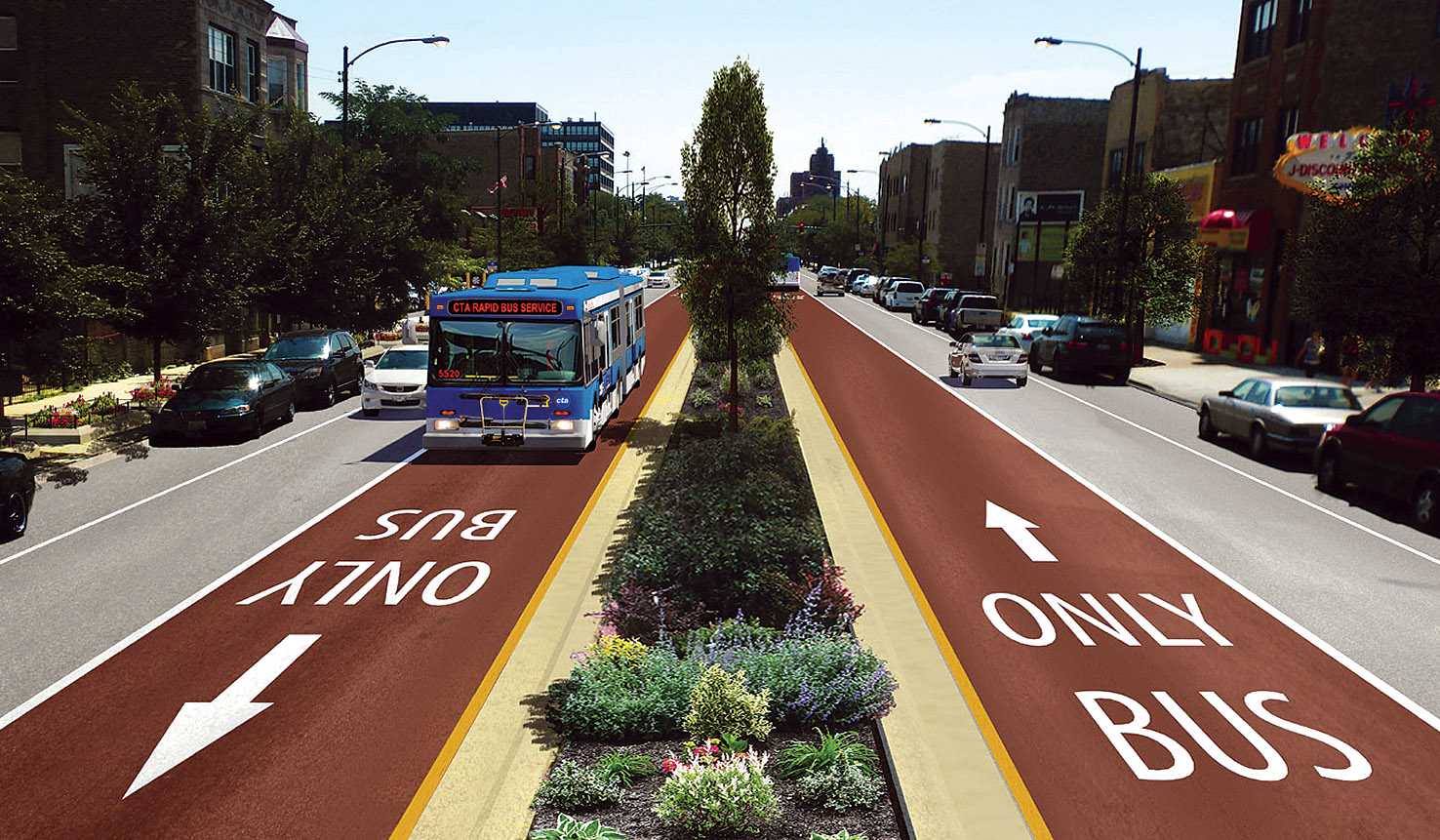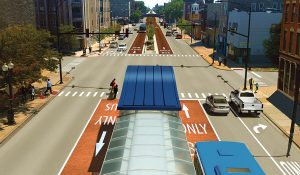
Community contributions stretch well beyond faster bus service
By Chrissy Mancini Nichols
Traffic congestion chokes greater Chicago at a cost of approximately $7.3 billion per year in wasted time and gas — not to mention environmental damage and the toll it takes on quality of life. Gridlock subjects drivers to significant stress and frustration. Still, people keep driving because their transit choices do not match their needs; and where they may be willing to take a train, building new rail lines becomes prohibitively expensive.
To that end, the Metropolitan Planning Council (MPC) completed a groundbreaking analysis in 2011, Bus Rapid Transit: Chicago’s New Route to Opportunity, which established a vision for the future of transportation and community development in and around Chicago.
MPC views Bus Rapid Transit (BRT) as a cost-effective transit solution that takes advantage of our existing assets — our city streets — to deliver fast, reliable transit on par with train service at a fraction of the cost of fixed rail.
This study provided the first comprehensive look at corridors in Chicago with strong BRT potential based on quantifiable livability criteria that considered job locations, education, medical facilities, public parks and libraries. After all, people do not ride buses and trains for the sake of the experience. They take public transit to get to where they need to go.
MPC identified and prioritized its top 10 potential BRT routes for opportunities to improve links between existing commuter rail and rapid transit lines, simplify crosstown trips and make the entire transit system a more attractive travel option.
At the same time, new transit investments could spur construction and economic development at station nodes throughout the city.
With support from the Rockefeller Foundation and a unique collaboration among city agencies and the nonprofit community, MPC has since conducted BRT advocacy of our goals for implementation, relying on the insight and unique expertise from our particularly effective steering committee comprised of the Chicago Transit Authority, Chicago DOT, Active Transportation Alliance and local partners.
Chicago Mayor Rahm Emanuel has prioritized the development of a BRT network, beginning with the first lines in the Central Loop and along Ashland Avenue, a major north-south thoroughfare on the west side, and one of the CTA’s busiest bus routes with 10 million boardings per year.
Central Loop BRT, where half of the people in vehicles are already on buses, will connect the 120,000 daily train riders at Chicago Union Station in the West Loop to East Loop businesses and Navy Pier, improving bus speeds by 7.5 minutes with only a 1.5 mile-per-hour reduction in traffic speed for vehicles on major streets.
Residents are on board with BRT
A survey conducted in July 2013 found that of those respondents familiar with BRT, 74 percent supported such a system in Chicago. 73 percent of respondents said they would take BRT instead of driving if their commute was faster.
BRT benefits local employers
Because one in four residents do not own a car, public transit is essential to growing Chicagoland’s economy.
MPC expects the BRT route along Ashland, expected to meet international gold-standard transit criteria, will significantly improve travel times for people making crosstown journeys to and from destinations not located within the downtown loop.
The six industrial zones accessible by Ashland BRT already provide about 64,000 well-paying jobs and have capacity to expand. For those employers looking to hire but having trouble finding enough qualified employees, a greater number of people within easy commute of industrial areas will mean better business outcomes.
BRT will also strengthen connections to areas specializing in healthcare and shorter commute times to and from the Illinois Medical District. This area suffers from poor access to north-south transit and overcrowded parking lots. BRT will make it easier for both workers and patients, which will attract a greater number of better-qualified employees. Executive Director Warren Ribley has expressed the need for better options for people coming to the Medical District, citing BRT as a critical component in the economic growth of this area.
The net effect of this investment means more people will be within a reasonable commute distance of more jobs — a need of high importance in areas with high unemployment and economic inactivity.
Coordinated community revitalization
Roughly one quarter of land in Chicago is in the public right-of-way, meaning transportation must play a broader role than just moving people from A to B. MPC sees BRT investments as transforming a place people speed through into a vibrant destination; a neighborhood and city asset where people work, shop, dine and hang out.
BRT investment spurs development
Over the past several years, MPC has held focus group discussions with real estate experts to discuss the benefits of BRT implementation. Their feedback indicates that BRT stations will be particularly attractive for residential investors.
MPC’s new development mapping tool (www.metroplanning.org/brtmap) offers in-depth information about available parcels, retail purchasing power, current zoning and potential financing to developers interested in building near BRT. We are making this tool available to local community groups, chambers and other stakeholders to spark investor interest.
MPC’s interactive map provides developers, community organizers and others with a tool for exploring the area around the proposed Ashland Avenue BRT corridor.
TOD loans give a boost
To explore expanded financing tools, MPC is leading a working group of the city, community development financial institutions and nonprofit leaders. Our goal is to establish an Equitable Growth Transit Oriented Development (TOD) loan fund to provide low-interest, competitive loans for the construction of mixed-income housing and jobs-focused economic development near transit stations, particularly those to be served by new BRT corridors.

Such cooperation by the public sector, foundations and nonprofits has allowed similar models in other metropolitan regions, such as Denver and the San Francisco Bay Area.
A TOD loan fund for the City of Chicago would focus on land acquisition and new construction around areas well served by transit to encourage strong clusters, spur economic development and create new jobs.
These goals are consistent with the Federal Transit Administration’s transit capital funding program guidelines, making Chicago more competitive for these limited resources to fund new BRT lines.
The Chicago Department of Planning and Development has begun a study of the Ashland BRT corridor to examine land use changes that would increase opportunities for community and economic development as implementation of BRT proceeds. MPC will analyze how the value created on this adjacent land and the value of tax proceeds can help finance initial costs.
At the same time, the Chicago Deptartment of Transportation is studying new BRT routes to create a network plan, designed to complement the existing rail transit system.
BRT encompasses much more than just faster buses; the concept is a sound investment for Chicago.
